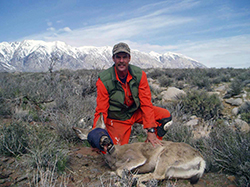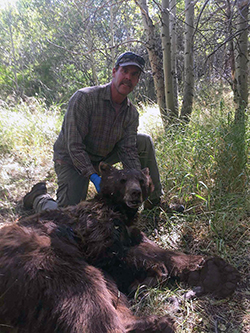
Tim working a deer capture in Round Valley. The deer was captured with a net gun, blindfolded, and hobbled for helicopter transport to base camp or a central processing station.

Tim radio-collared and took samples from this anesthetized black bear during the 2016 Eastern Sierra Black Bear Study.
Tim Taylor is an environmental scientist for CDFW’s Inland Desert Region, which includes Imperial, Inyo, Mono, Riverside and San Bernardino counties. He has spent his entire 17-year CDFW career in a single area of study – the Eastern Sierra – and he is only the third Mono County unit biologist in department history.
Like many other CDFW scientists, Tim earned his Bachelor of Science in wildlife management at Humboldt State. The Southern California native did myriad odd jobs to get through college, including working on a ski lift, putting up drywall and even thinning trees and fighting fires. After college, he worked as an independent biologist throughout California, Oregon and Nevada, conducting wildlife assessment surveys for a wide range of threatened and endangered species including desert tortoise, red-legged frog, spotted owl and Sierra Nevada red fox.
Today, Tim’s primary job duties include monitoring diverse wildlife species – including sage grouse, deer, pronghorn and bears – in a part of the state most Californians never have the opportunity to experience.
Who or what inspired you to pursue a career in wildlife biology?
When I was a kid growing up in the June Lake area of the eastern Sierra, I always knew I wanted to be a wildlife biologist. I had the good fortune of getting to know the very first CDFW wildlife biologist for the Mono unit, Andy Anderson, and he took me into the field with him whenever possible. I got to participate in some amazing wildlife work, like trapping and relocating nuisance black bears (when we used to do that!), rearing Canada goose goslings, counting strutting sage-grouse and helping at deer hunter check stations. This work provided me with an early appreciation and knowledge of eastern Sierra wildlife and their habitats, and from that time on, the Mono unit biologist position became my dream job.
After Andy retired, I became good friends with his successor, Ron Thomas. He was also a great mentor. I started working for CDFW in the Sierra Nevada bighorn sheep program with the hope of eventually transferring to the Mono unit position. Fortunately, after Ron retired, I was in the right place at the right time.
What are your current responsibilities?
Working as a unit wildlife biologist requires being a generalist with the knowledge and understanding of all wildlife that inhabit my work area. During any given day I can deal with a number of different wildlife species issues like sage-grouse habitat conservation, mule deer and pronghorn research, nuisance black bear complaints and talking with deer hunters about the best place to find a buck. My duties include wildlife resource assessment, habitat enhancement planning and implementation, hunting management, nuisance wildlife response and environmental review. I am currently involved with a number of different wildlife research projects, including a sage-grouse translocation effort to rescue a small, isolated sub-population near the Mono basin and a GPS collaring study of black bears to determine home range distribution and habitat use.
I also occasionally provide advice on how to reduce human-bear conflicts at the Mountain Warfare Training Center, a US Marine Corps installation in Mono County. I review environmental documents that relate to their training area, and work with new recruits on how to identify animals, as part of their survival training.
Which species do you work with most frequently?
Mule deer are the most conspicuous and widespread large mammal in the eastern Sierra. Mono county supports five large migratory herds. I manage 2 mule deer hunt zones, X12 and X9a. Hunt zone X12 comprises three herds that occupy northern Mono County. These are interstate herds that are jointly managed for hunting purposes by CDFW and the Nevada Department of Wildlife. Zone X9a comprises two herds that occupy southern and central Mono County. Those are managed solely by CDFW. Along with other CDFW biologists, I conduct population surveys and collect data on vital rates and nutritional condition as part of an integrated population monitoring approach for assessing the status of local deer herds.
Mono County also supports a large population of greater sage-grouse, which is part of the Bi-state Distinct Population Segment (DPS) of greater sage-grouse. The Bi-state DPS, which is genetically distinct from other sage-grouse across the range, occupies sagebrush habitat in Inyo and Mono counties in California and Douglas, Mineral, Lyon and Esmeralda counties in Nevada. Sage-grouse is a sagebrush obligate species, meaning it relies on sagebrush for its survival. They are also an umbrella species, used in making conservation related decisions that affect the sagebrush ecosystem. Our efforts to conserve the sage-grouse indirectly protects other sagebrush obligate species, such as pygmy rabbit and Brewer’s sparrow, that inhabit the sagebrush ecosystem.
Then there’s the eastern Sierra black bear. Their population has increased dramatically over the last 10 years, and therefore has created numerous management challenges. In most of the rural east side towns there is no regular garbage pickup, so people store their trash and take it to a landfill. This creates a situation where bears have open access to garbage that is not properly secured in a building or bear-proof container. Once a bear has become food-conditioned, it’s pretty much over. It will start breaking into homes and cabins next.
What project or accomplishment are you most proud of?
In 2007, CDFW acquired 1,160 acres of critical greater sage-grouse habitat in northern Mono County, which included two strutting grounds, brood rearing meadows and winter habitat. Approximately 900 of the 1,160 acres was proposed to be subdivided into 40 acre parcels, which included the only two remaining leks for this sub-population of sage-grouse, as well as some critical mule deer migration and summer range habitat. CDFW acted in a timely manner in acquiring the property, and in doing so, prevented the loss of this critical sage-grouse habitat.
Without the acquisition and eventual conversion of the property into a State Wildlife Area, these leks would have been destroyed resulting in the extirpation of this sage-grouse sub-population.
The acquisition was funded by the Wildlife Conservation Board, and was especially important because it was one of the many conservation actions that helped to prevent the federal listing of the Bi-state greater sage-grouse.
What project would you most like to do, given unlimited time or resources?
I would implement several much needed wildlife crossing projects that would include a combination of underpasses, overpasses and fencing to allow deer, bears and other wildlife safe passage across highway 395 in Mono County.
What do you love most about your job?
The fact that I have the flexibility to work with so many different wildlife species on so many different projects.
What advice would you have for a young scientist wanting to do what you do?
Try to become as diversified as possible with respect to your knowledge of wildlife throughout the state. Working as a unit biologist requires multiple species management so become a naturalist and develop a broad understanding of the species that inhabit your work area.
Photos courtesy of Tim Taylor
Top photo: Tim working on a Round Valley deer herd capture team